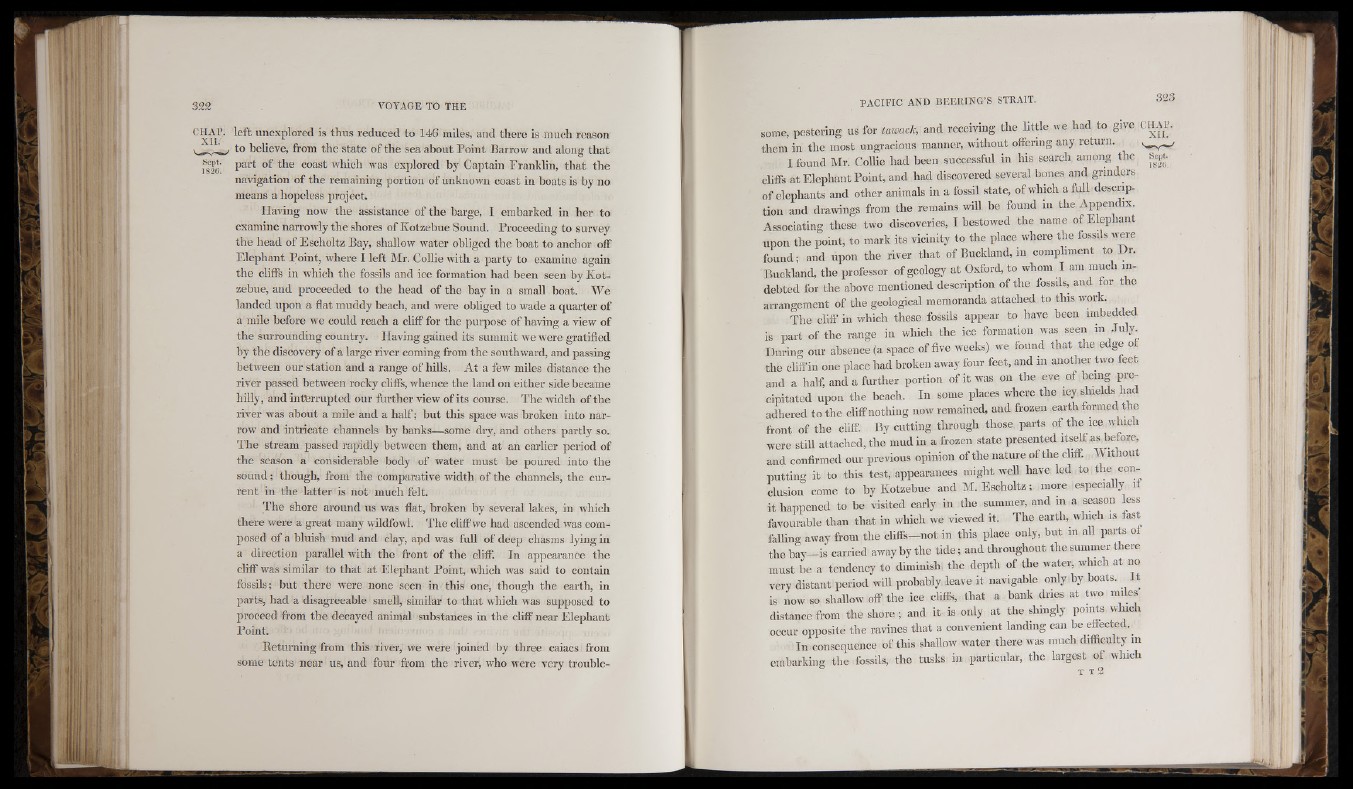
i
CHAI’. left unexplored is thus reduced to 146 miles, and there is much reason
to believe, from the state of the sea about Point Barrow and along that
which was explored by Captain Franklin, that the
navigation of the remaining portion of unknown coast in boats is by no
means a hopeless project.
Having now’ the assistance of the barge, 1 embarked in her to
examine narrowly the shores of Kotzebue Sound. Proceeding to survey
the head of Escholtz Bay, shallow water obliged the boat to anchor off
Elephant Point, where I left Mr. Collie with a party to examine again
the cliffs in which the fossils and ice formation had been seen by Kotzebue,
and proceeded to the head of the bay in a small boat.
landed upon a flat muddy beach, and were obliged to wade a quarter of
a mile before we could reach a cliff for the purpose of having a view of
the surrounding country. Having gained its summit we were gratified
by the discovery of a large river coming from the southward, and passing
between our station and a range of hills. At a few miles distance the
river passed between rocky chffs, whence the land on either side became
hilly, and intferrupted our further view of its course. The width of the
river was about a mile and a half; but this space was broken into narrow
and intricate channels by banks—some dry, and others partly so.
The stream passed rapidly between them, and at an earlier period of
the season a considerable body of water must be poured into the
sound; though, from the comparative width of the channels, the current
in the latter is not much felt.
The shore around us was flat, broken by several lakes, in which
there were a great many wildfowl. The cliff we had ascended was composed
of a bluish mud and clay, and was full of deep chasms lying in
a direction parallel with the front of the cliff. In appearance the
cliff W'as similar to that at Elephant Point, which was said to contain
fossils; but there were none seen in this one, though the earth, in
parts, had a disagreeable smell, similar to that which was supposed to
proceed from the decayed animal substances in the cliff near Elephant
Point.
Returning from this river, we were joined by three caiacs from
some tents near us, and four from the river, who were very troublesome,
pestering us for tawack, and receiving the little we had to give
them in the most ungracious manner, without offering any return.
I found Mr. Collie had been successful in his search among the
cliffs at Elephant Point, and had discovered several bones and grinders
of elephants and other animals in a fossil state, of which a full description
and drawings from the remains will be found m the Appendix.
Associating these two discoveries, I bestowed the name of Elephant
upon the point, to mark its vicinity to the place where the fossils were
found; and upon the river that of Buckland, in compliment to Dr.
Buckland, the professor of geology at Oxford, to whom I am much indebted
for the above mentioned description of the fossils, and lor the
arrangement of the geological memoranda attached to this work.
The cliff in which these fossils appear to have been imbedded
is part of the range in which the ice formation was seen in .July
During our absence (a space of five weeks) we found that the edge of
the cliffin one place had broken away four feet, and iii another two feet
and a half, and a further portion o fit was on the eve of being iire-
cipitated upon the beach. In some places where the icy shields had
adhered to the cliff nothing now remained, and frozen earth formed the
front of the ciiff. By cutting through those parts of the ice which
were still attached, the mud in a frozen state presented itself as before,
and confirmed our previous opinion of the nature of the cliff. YVithout
putting it to this test, appearances might weU have led to the conclusion
come to by Kotzebue and M. Escholtz; more especially if
it happened to be visited early in the summer, and in a season less
favourable than that in which we viewed it. The earth, w'hich is fast
fallino' away from the c liffs-n o t in this place only, but in all parts oi
the b a y -is carried away by the tide; and throughout the summer there
must be a tendency to diminish the depth of the water, which at no
very distant period will probably leave it navigable only by boats. It
is now so shallow off the ice cliffs, that a bank dries at two miles
distance from the shore; and it is only at the shingly points which
occur opposite the ravines that a convenient landing can be effected.
In consequence of this shallow water there was much difficulty in
embarking the fossils, the tusks in particular, the largest of which